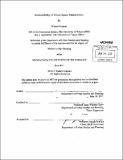| dc.contributor.advisor | Anne Whiston Spirn. | en_US |
| dc.contributor.author | Nomura, Wataru | en_US |
| dc.contributor.other | Massachusetts Institute of Technology. Dept. of Urban Studies and Planning. | en_US |
| dc.coverage.spatial | a-ja--- | en_US |
| dc.date.accessioned | 2011-11-18T21:05:15Z | |
| dc.date.available | 2011-11-18T21:05:15Z | |
| dc.date.copyright | 2011 | en_US |
| dc.date.issued | 2011 | en_US |
| dc.identifier.uri | http://hdl.handle.net/1721.1/67232 | |
| dc.description | Thesis (M.C.P.)--Massachusetts Institute of Technology, Dept. of Urban Studies and Planning, 2011. | en_US |
| dc.description | Cataloged from PDF version of thesis. | en_US |
| dc.description | Includes bibliographical references (p. 84-94). | en_US |
| dc.description.abstract | In Japan, recent changes in socio-economic and political structures -- decreasing tax revenue, declining communication among community members, and privatization of public services-- have influenced existing maintenance systems initiated by the public sector. In this study, I examine maintenance systems of green spaces, identify the limits and possibilities of these practices, and conduct a literature review of US and UK cases to obtain some ideas for future practices in Japan. The current Japanese practices aim to utilize the resources which had not been fully integrated with existing maintenance systems, such as private corporations and community and volunteer groups. The case studies clarified three keys for making these practices sustainable: long-term strategies, self-sustained volunteer and community activities, and multiple funding streams. In the circumstance where the public sector suffers long-lasting financial hardship, these practices need to be developed further. To apply a model of green space maintenance in one country to other countries is not easy because cultural, social and political differences have significant impacts. Both in the UK and the US practices show the importance and difficulties of approaching multiple and sustainable funding streams. However, despite the differences of backgrounds, especially of donation culture, the approaches found in the US practices -- public and private partnerships for creating long-term strategy, helping community activities become self-sustained, developing public outreach-- would help Japanese to further its efforts to establish a sustainable system for green space maintenance. | en_US |
| dc.description.statementofresponsibility | by Wataru Nomura. | en_US |
| dc.format.extent | 94 p. | en_US |
| dc.language.iso | eng | en_US |
| dc.publisher | Massachusetts Institute of Technology | en_US |
| dc.rights | M.I.T. theses are protected by
copyright. They may be viewed from this source for any purpose, but
reproduction or distribution in any format is prohibited without written
permission. See provided URL for inquiries about permission. | en_US |
| dc.rights.uri | http://dspace.mit.edu/handle/1721.1/7582 | en_US |
| dc.subject | Urban Studies and Planning. | en_US |
| dc.title | Sustainability of green space maintenance | en_US |
| dc.type | Thesis | en_US |
| dc.description.degree | M.C.P. | en_US |
| dc.contributor.department | Massachusetts Institute of Technology. Department of Urban Studies and Planning | |
| dc.identifier.oclc | 759121273 | en_US |
